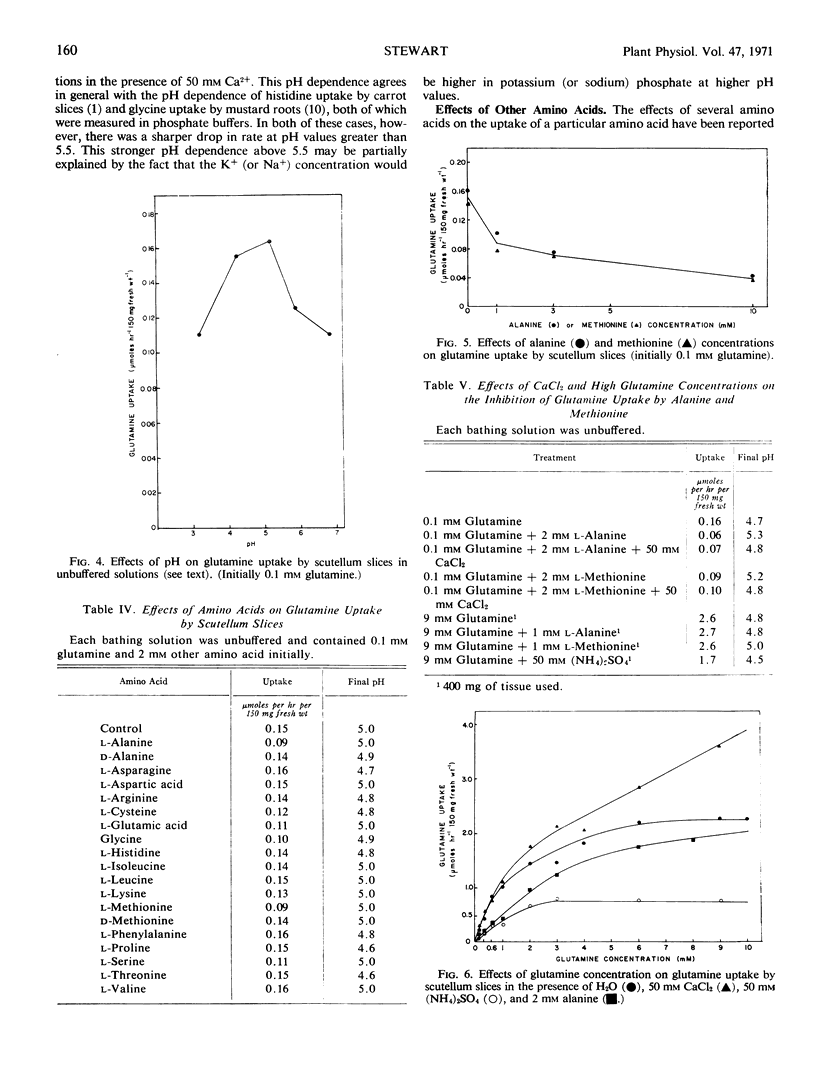Abstract
Slices of corn scutellum were used to study amino acid uptake, a natural function of this tissue. The uptake of glutamine was found to be inhibited by several monovalent cations. The accompanying anion did not affect the inhibition. Divalent cations stimulated glutamine uptake, particularly at high glutamine concentrations. The inhibition by monovalent cations was reversed by divalent cations.
There was a broad pH optimum (4.3-5.2), and a wide range of pH values over which substantial rates of glutamine uptake were observed (3-7).
Seventeen protein amino acids were tested for their effects on glutamine uptake. l-Alanine, l-cysteine, l-glutamic acid, glycine, l-serine, and l-methionine were the only inhibitory amino acids. The inhibition by alanine and methionine was overcome at high glutamine concentrations whereas the inhibition by monovalent cations was not. The inhibition by amino acids was not reversed by divalent cations. d-Alanine and d-methionine had no effect on glutamine uptake.
High concentrations of sucrose (0.5 m) did not affect glutamine uptake. Thus, osmotic shock did not cause a dissociation of a transport protein from a membrane. Mannose inhibited glutamine uptake but glucose, galactose, and fructose did not. In addition to respiratory inhibitors, N-ethylmaleimide inhibited glutamine uptake. Ouabain did not affect glutamine uptake.
Full text
PDF




Selected References
These references are in PubMed. This may not be the complete list of references from this article.
- BIRT L. M., HIRD F. J. Kinetic aspects of the uptake of amino acids by carrot tissue. Biochem J. 1958 Oct;70(2):286–292. doi: 10.1042/bj0700286. [DOI] [PMC free article] [PubMed] [Google Scholar]
- BIRT L. M., HIRD F. J. The uptake and metabolism of amino acids by slices of carrot. Biochem J. 1958 Oct;70(2):277–286. doi: 10.1042/bj0700277. [DOI] [PMC free article] [PubMed] [Google Scholar]
- BIRT L. M., HIRD F. J. The uptake of amino acids by carrot slices. Biochem J. 1956 Oct;64(2):305–311. doi: 10.1042/bj0640305. [DOI] [PMC free article] [PubMed] [Google Scholar]
- Kriedemann P., Beevers H. Sugar uptake and translocation in the castor bean seedling I. Characteristics of transfer in intact and excised seedlings. Plant Physiol. 1967 Feb;42(2):161–173. doi: 10.1104/pp.42.2.161. [DOI] [PMC free article] [PubMed] [Google Scholar]
- Pardee A. B. Membrane transport proteins. Proteins that appear to be parts of membrane transport systems are being isolated and characterized. Science. 1968 Nov 8;162(3854):632–637. doi: 10.1126/science.162.3854.632. [DOI] [PubMed] [Google Scholar]
- WRIGHT D. E. Amino acid uptake by plant roots. Arch Biochem Biophys. 1962 Apr;97:174–180. doi: 10.1016/0003-9861(62)90061-9. [DOI] [PubMed] [Google Scholar]


